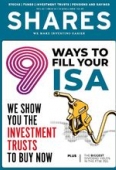Archived article
Please note that tax, investment, pension and ISA rules can change and the information and any views contained in this article may now be inaccurate.
It is time to wave goodbye to the conglomerate model

Conglomerate has become a dirty word as owning various businesses operating in different industries is no longer seen as relevant in the modern world. The returns for investors in these stocks also haven’t been great.
It is very hard for a board to run a company with lots of complex parts and you can’t expect directors to be experts in different end-markets. Quite often the disclosure is poor for each part of the business and it can be very difficult for investors to analyse and value such companies.
The trend in recent years has been to break up conglomerates and we continue to see more of this on a regular basis. For example, industrial group Thyssenkrupp last September buckled under shareholder pressure and announced plans to split into two, although subsequently its share price has been brutally punished as earnings have been hit by higher costs and tariffs.
Conglomerates on the UK stock market include industrials specialist Smiths Group (SMIN) which has already started the process of spinning off its medical arm. Other relevant UK names include Carr’s (CARR) which sold its food division in 2016, leaving it focused on agriculture and engineering; and Avon Rubber (AVON) which makes gas masks and cow milking systems.
It is hoped that breaking up conglomerates will unlock hidden value and allow businesses to be run with more focus. However, there continues to be some reluctance among certain companies
to abandon the conglomerate structure, most notably Associated British Foods (ABF) on the UK stock market.
It has long shrugged off suggestions it should split into two or three parts: a sugar and/or a foods business, and the Primark retail chain.
Having different parts can act as a cushion if one component isn’t doing well. Also in conglomerates’ favour is the general ability for larger businesses to borrow more cheaply than smaller ones, and diversification further reduces risk from the lenders’ perspective.
Analysts at investment bank Jefferies imply the negatives far outweigh the positives. They warn that conglomerates have more places to hide and say: ‘Complexity and opacity make it harder for managers and investors to understand what is going on. This creates opportunities for managers to bury bad news.’
Large conglomerates often have close relationships with government because of their size and diversity. This isn’t always good for shareholders as the companies can be pressurised into not making the right decisions, such as keeping an under-utilised factory open, or taking on vanity projects that fit the government’s agenda.
The cult of the CEO also comes with the conglomerate territory, where a skilled executive turns into a cult figure due to constant publicity they get from making acquisitions – and then they lose touch with reality. Poor capital allocation and hidden or excessive costs are other negative factors to consider.
Jefferies’ analysts foresee major change among current conglomerates. However, the model will inevitably become trendy again once companies find it hard to achieve organic growth. At that point, boards normally turn to acquisitions to drive growth and eventually there will be the suggestion that it is time to build another empire across multiple markets.
Important information:
These articles are provided by Shares magazine which is published by AJ Bell Media, a part of AJ Bell. Shares is not written by AJ Bell.
Shares is provided for your general information and use and is not a personal recommendation to invest. It is not intended to be relied upon by you in making or not making any investment decisions. The investments referred to in these articles will not be suitable for all investors. If in doubt please seek appropriate independent financial advice.
Investors acting on the information in these articles do so at their own risk and AJ Bell Media and its staff do not accept liability for losses suffered by investors as a result of their investment decisions.
Issue contents
Big News
- The week's big news: Saga, Debenhams and more
- Funding Circle income fund to close after performance flop
- Brexit blamed for worst business investment figures since 2008
- Superdry shares still weak despite Dunkerton win
- Jupiter European funds downgraded as star manager set to step down
- Lack of IPOs is bad news for brokers

 magazine
magazine









